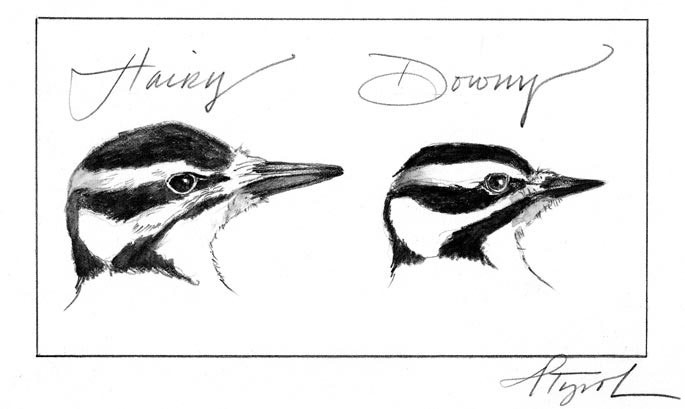
“That’s a downy. No wait, it’s a hairy – definitely a hairy. Well, hang on...maybe it is a downy.” I admit it: I’ve had this happen to me more than once.
With the onset of winter, downy and hairy woodpeckers become more apparent– knocking away in our woods and stopping by our birdfeeders. With strikingly similar feather patterns, the two can be hard to distinguish if one only catches a glimpse. Both have black wings with white markings; white bellies, sides, and backs; and distinctively white- and black-striped heads. Males of both species have red patches on the backs of their heads, which females lack. While seasoned birders can tell the difference between the two birds’ calls and the shade of white on the tail feathers, the most reliable visual differences are that hairies are larger (by about 1.5 inches and 2 ounces) and have more solid, longer bills than downies.
Because of such striking similarities, one might assume that downies and hairies are very closely related, even that they’re probably each other’s closest relatives (“sister species” in evolutionary biology lingo) – just like our white tailed deer and the west’s mule deer are.
Evolutionary biologists had reached exactly the same conclusion – that is until DNA sequencing allowed them to bypass comparing traits like weight, size, and color and go right to the source when determining evolutionary relationship. What the genes show is that downies and hairies aren’t evolutionary sisters. The two species are related: they are both in the genus Picoides. But, the genus is separated into two branches. In one group is the downy woodpecker, with its closest relatives: the Nuttall’s, the ladder-backed, and the lesser spotted woodpeckers. The other branch contains the hairy woodpecker and its closest relatives: the Arizona, white-headed, and red-cockaded woodpeckers.
But how can two species look almost identical without being immediate relatives? One theory is convergent evolution. Think of bats and birds, which both have wings, but aren’t close relatives, or crocodiles and hippopotamuses, which both have eyes on the tops of their heads, but also aren’t close relatives. When species evolve from different backgrounds toward a similar state, it’s called convergent evolution. So, if this is the cause of the woodpecker similarity, then the ancestors of these two species looked different, but slowly evolved to look similar to each other over time.
Support for this idea comes from the observation that hairy woodpeckers living well outside the range of downies (in Central America) have begun to morph in color: they have brownish underparts, as opposed to the white found on birds in the northeast. It’s almost as if they are free to change appearance when downy woodpeckers are not present, but when the two live together, they are constrained to look the same by some force of evolution.
What could that force be? Convergent evolution occurs for a variety of reasons. For instance, our harmless eastern milk snake evolved to look like the venomous northern copperhead snake. This similarity benefits milk snakes, which predators may confuse for venomous copperheads and avoid, losing out on an easy meal.
In the case of our woodpeckers, however, we have no evidence that either species is venomous.
Instead, some scientists suspect that the similarity between downies and hairies could be related to territoriality. Both woodpeckers compete for limited resources: food and trees that provide nesting cavities. Converging on a similar look may be a way for birds with brains the size of a pea, to identify competitors more easily: all they have to do is shoo away any bird that looks like them.
The territoriality hypothesis hasn’t been tested yet, though, so we don’t know the full story. What we do know is that even some of our most familiar birds hold riddles that we have yet to decipher.


Discussion *